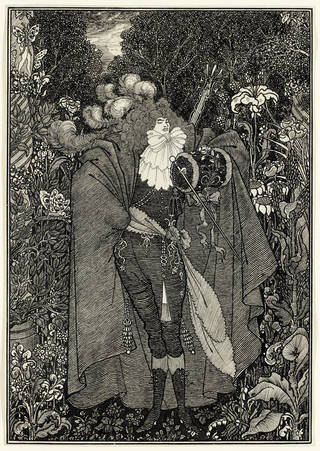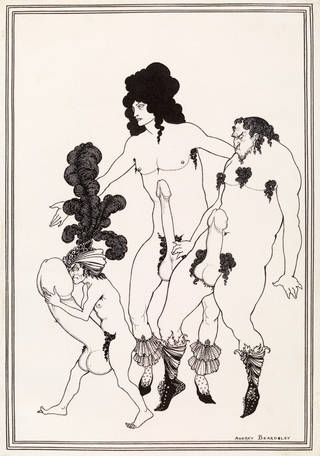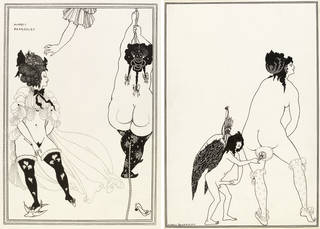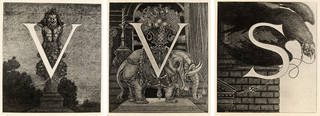Aubrey Beardsley (1872 – 98) was an artist whose illustrative work burned brightly, but briefly, until his death aged just 25. To many, he and his art personify the fin de siècle 1890s, 'the Beardsley age' of decadence, of the rejection of moral and aesthetic convention in favour of perversity and scepticism, and of delight in the exotic, the scandalous, the sensational.
Beardsley's style is sophisticated and refined, the lines elegant and the subjects often classical, but his treatment of them is subversive, provocative and frequently obscene. These contradictions lie at the heart of Beardsley's aesthetic appeal, as visual pleasure is both undercut and enhanced by ugly content, eliciting a shiver of disgusted delight.
"I have one aim – the grotesque. If I am not grotesque, I am nothing"
First steps in art
Aubrey Vincent Beardsley was born on 21 August 1872, in Brighton, England. His mother, the daughter of an Indian Army surgeon, was cultured and ambitious for Aubrey and his older sister Mabel, ensuring their education in music, literature, art and performance. At the age of 16 he took employment as a clerk in London, first with a district surveyor, then with an insurance firm, where his salary helped maintain the family.
His first finished drawings illustrated his reading of French novels and Restoration drama, but the pursuit of work and art was interrupted by recurrent attacks of tuberculosis meaning he was often unable to work or leave his home. Now, influence from the artists Dante Gabriel Rossetti (founder member of the Pre-Raphaelites) and James Abbott McNeill Whistler and Edward Burne-Jones (leading figures in the Aesthetic movement) became visible in his work.
In the summer of 1891 Aubrey and Mabel visited the London home of shipowner Frederick Leyland to see his collection of works by the Pre-Raphaelites and his famous Peacock Room, a sumptuous interior scheme painted by Whistler. On a subsequent weekend the Beardsleys aimed for what they thought was an open afternoon at Burne-Jones's studio. Finding they were mistaken, the young visitors were initially turned away, but then summoned back. As well as welcoming them, Burne-Jones also looked at the portfolio Aubrey always carried with him. Aubrey later described the occasion:
"I can tell you it was an exciting moment when he first opened my portfolio and looked at the first drawings ... After he had examined them for a few minutes he exclaimed, 'There is no doubt about your gift, one day you will most assuredly paint very great and beautiful pictures'".
This momentous endorsement launched Beardsley's career. Burne-Jones showed him round the studio, made introductions and recommended formal study at art school. "Design as much as you can; your early sketches will be of immense service to you later on. Every one of the drawings you have shown me would make beautiful paintings ... All are full of thought, poetry and imagination".
Beardsley enrolled for evening sessions at Westminster School of Art under Professor Fred Brown, making careful studies in pencil and charcoal. Brown's teaching emphasised outline, composition and individual expression. Here, Beardsley also discovered the graphic work of the designer and illustrator Walter Crane, and received advice on line drawing in pen and ink.
Early commissions
If Beardsley had previously aspired to paint 'very great and beautiful pictures', he was diverted back into drawing by a commission from the publishers J.M. Dent to illustrate Le Morte Darthur, Sir Thomas Malory's late medieval version of the legends of King Arthur and his knights of the Round Table.
The drawings were to be done in 'medieval manner', similar in style to those being produced at William Morris's Kelmscott Press. The payments for what turned out to be hundreds of elaborate borders, initials, ornaments and full-page pictures enabled Beardsley to quit office work, and would tie him to line drawing for reproduction via lithography. Known as 'black-and-white' work, this was the medium of the age, as technology developed for illustrated books, magazines and advertisements.
Other commissions followed swiftly, one being for an untitled series of grotesque artworks, another being for the Vera Historia by the Greek writer Lucian. These, Beardsley boasted, "are certainly the most extraordinary things that have ever appeared in a book both in respect of technique and conception. They are also the most indecent. I have thirty little drawings to do for it". He also had an assignment for a weekly paper, the Pall Mall Budget. All these early commissions provided invaluable training in design to order, which demanded continuous invention and swift execution.
Salome
Through his art school teacher, Beardsley exhibited line drawings at the New English Art Club, an alternative, more 'modern' London venue launched in 1885. One was his first depiction of Salome caressing the severed head of John the Baptist, which together with other drawings reproduced in the arts magazine The Studio, led to a commission from the publisher John Lane to illustrate an edition of Oscar Wilde's play Salome (1894). Beardsley knew Wilde through his new friends Robert Ross, a journalist and art critic, artist Will Rothenstein and caricaturist-cum-dandy Max Beerbohm.
The illustrations were in a truly new mode. The swooping lines and variegated patterning reflect Beardsley's admiration for Whistler's peacocks and Japanese shunga (erotic art) woodblocks, while the compositions, with figures often floating high on the page and wearing the latest fashion, visually matched Wilde's extravagant dialogue. The sexual element of the Salome illustrations is clearly but coldly conveyed, with naked nipples and naked boys, while the many details (drawn from the text) create tense, unbalanced compositions. Like much of the public and press, The Times condemned the illustrations as "fantastic, grotesque, unintelligible, repulsive". This reception was of course success by scandal.
The Yellow Book
Beardsley's flame continued to blaze with the launch of The Yellow Book in spring 1894. This was a new form of magazine using the latest image-reproduction technology. As art editor and principal illustrator, Beardsley was swift to exploit the latest line-block printing process. This enabled him to make dramatic use of black and white space. Generally, Beardsley's designs purposefully represented modern life, modern dress, modern costume and modern celebrities.

Beardsley claimed prodigy status, declaring that his artistic mode was entirely personal. People "appear differently to me than they do to others; to me they are mostly grotesque and I represent them as I see them", he said. "Surely it is not my fault if they fall into certain lines and angles". He implied, too, that the designs were effortless, and always completed by candlelight in almost mystic seclusion. In fact, and thankfully, they were carefully crafted.
New projects and sexuality
In April 1895 Oscar Wilde was arrested for gross indecency – that is, sex with other men. During his arrest he was found to be carrying – perhaps deliberately – a yellow-covered novel, which was immediately misidentified as The Yellow Book. A moral panic ensued. Several eminent authors demanded that the publisher withdraw all Beardsley's designs and he was dismissed as art editor.
Although his health worsened, he turned to new pictorial projects of his own choosing. These included an elaborate retelling of the Tannhäuser legend with equally elaborate illustrations in rococo mode. "I am just doing a picture of Venus feeding her pet unicorns which have garlands of roses about their necks", he told the British photographer Frederick Evans.

He acquired new patrons, one being André Raffalovich, French-born poet and writer on homosexual 'inversion', and another Leonard Smithers, a lawyer-turned-bookseller with a special interest in classical pornography. Both were hot topics at this time and for Decadents, both were sticks with which to disgust the bourgeois and affirm their freedom from prudish convention. Beardsley frequently boasted of the indecency of his images.
Owing to the company he kept, his own sexuality has been much debated. His dandy's attire, literary and theatrical tastes and socio-aesthetic friendships in the context of 1890s culture all suggest a gay identity that remains unconfirmed and indeed doubtful. Though his aesthete's pose was genuine, his style seems not to have been what was later called 'camp'. The Irish poet W.B. Yeats recalled him with a hangover contemplating his reflection in a mirror and saying, "Yes, yes, I look like a sodomite. But no, I am not that", and was himself convinced that Beardsley had "no sexual abnormality". Homosexual acts, in public or private, were of course illegal, as Wilde's conviction demonstrated, but Beardsley's assertion about himself was surely accurate.
Wilde acutely noted the affinity of Beardsley's images to "the naughty scribbles [of] a precocious boy", and the monstrous erections he drew in Aristophanes' Lysistrata are certainly reminiscent of the long tradition of such scrawls on walls and toilet doors. Whether or not the drawings were arousing, they certainly still appear shocking and obscene. Using Victorian pornography as a yardstick, Burne-Jones found Beardsley's works "detestable ... more lustful than any I've seen – not that I've seen many such. There was a woman with breasts each larger than her head, which was quite tiny and features insignificant, so that she looked like a mere lustful animal".

The Savoy
Smithers offered to support a successor-rival to The Yellow Book, under the joint editorship of Beardsley and Arthur Symons, who admired the French poets Baudelaire and Verlaine and had written on the Symbolist movement in literature. As co-founder of The Savoy, Beardsley was able to pursue his writing as well as illustration, and a number of his writings, including Under the Hill (a story based on the Tannhäuser legend) and The Ballad of a Barber appeared in the magazine.
His new pictorial style flourished in illustrations to Alexander Pope's mock-heroic poem The Rape of the Lock. In place of the dramatic contrasts of black and white, these all-over patterned designs are confusingly crammed with intricate detail. Whistler, surprised by the change, declared his support, saying "Aubrey, I have made a very great mistake – you are a very great artist".

When Smithers proposed an illustrated version of Aristophanes' comedy Lysistrata, about an anti-war 'sex strike' by Greek women, which would evade prosecution for obscenity if sold 'privately' rather than through the book trade, Beardsley seized on the idea. He produced a sequence of outrageous images, returning to the outline mode, depicting sexual frustration in both sexes and featuring especially outsize, elegantly outlined penises. Copied from erotic Japanese prints, these must have shocked and excited his (male) audience and identified his art as no longer 'weird' but salacious.

Following a bout of serious sickness in Brussels in spring 1896, Beardsley was unable to travel unaided or climb stairs without coughing blood. He was confined to beds and sofas and on medical advice banished from London's polluted atmosphere. In Epsom, Surrey, he drew the Lysistrata illustrations and in Boscombe, Hampshire, illustrations to the satire Against Women by the Roman poet Juvenal.
Last illustrations and death
Aware of Beardsley's failing health, Smithers proposed an 'album' of 50 drawings, essentially as a memorial volume. Beardsley was energised, producing illustrations to Das Rheingold. Next came the famous cross-dressing Mademoiselle de Maupin, cast as a fictional heroine by Théophile Gautier in what became a sourcebook of gender fluidity for the Aesthetic movement.

In autumn 1897, Beardsley moved to Menton on the French Riviera and started work on a new project, illustrating the Jacobean drama Volpone, by Ben Jonson, about a monstrous miser. Volpone was "a splendid sinner", he wrote, who compelled "admiration by the fine-ness and very excess of his wickedness ... we are scarcely shocked by his lust, so magnificent is the vehemence of his passion, and we marvel and are aghast rather than disgusted by his cunning and audacity". The book, he declared with deathbed ambition, would be in his new 'grand style', a compelling example of graphic imagination.

Aubrey Beardsley died in Menton on 16 March 1898, aged 25, with many such projects unfulfilled. Friends and followers mourned the premature loss of such skill, invention and creative energy that would surely have continued to startle, delight and confound viewers, had he lived.

This is an edited extract from Aubrey Beardsley: Decadence & Desire by Jan Marsh, published by Thames & Hudson Ltd, London, in association with the Victoria and Albert Museum


